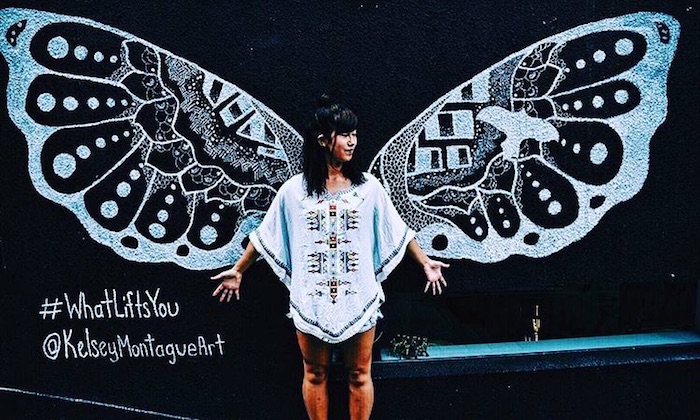Street Art Tour
We’re lucky enough to live in a city that’s surrounded by lush greenery and mountains, treats us to beautiful beaches, and also has a vibrant city life. However, there’s another aspect to HK’s gorgeous aesthetics which can be overlooked – its creative and whimsical street art.
All over the city, you’ll see walls, shutters and entire buildings covered in incredible street art. Some of the pieces are ‘in your face’ and full of colours, whilst others are a little more discreet and can be harder to find. So, in celebration of Art Month and our buzzing city, we’ve rounded up a few of our favourite street art pieces (and we show you where to find them for your Instagram pages!).

#WhatLiftsYou Wings
International street artist, Kelsey Montague is well-known for her famous sets of wings which are scattered around cities worldwide. As part of her #WhatLiftsYou campaign, Kelsey set about to provide people with the opportunity to share more about what inspires them and to interact with her art. Our wings in HK may be a little on the small side, but we still love them and the message they represent!
Artist: Kelsey Montague – see more of her work here
Where to Find It: Mid-levels, Hong Kong

Rainbow Thief
Madrid-based Spanish artist, Okuda, worked in conjunction with HKWalls in 2016 and transformed a worn-down, old building with his vibrant and eye-catching bear. Taking three days to complete, the incredible rainbow-coloured three-dimensional work of art has transformed this old Kowloon neighbourhood, and is one of our favourite street arts pieces in the 852.
Artist: Okuda – see more of his work here
Where to Find It: 180 Tai Nan Street, Sham Shui Po, Hong Kong

Fox Multi Coloured
Yet another street art mural that was created during ‘HKWalls.’ Fox Multi Coloured came to life in 2015, by Thai street artist Rukkit Kuanhawate. With his signature colourful, geometric style making the piece a regular feature on Instagram!
Image by Tracy Wong, sourced via Home Journal
Artist: Rukkit – see more of his work here
Where to Find It: Upper Station Street, Sheung Wan, Hong Kong

Untitled
Painted on the corner of Hollywood Road, Hopare‘s work is a beautiful mix of portraiture, combined with abstract shapes and fluid lines. The talented French artist’s distinctive style can be seen at a few locations around town, so be sure to keep an eye out!
Artist: Hopare – see more of his work here
Where to Find It: Hollywood Road, Sheung Wan, Hong Kong

Mong Kok Graffiti Wall of Fame
Hidden from away from bustling Argyle Street sits this secret alleyway, nicknamed “the graffiti wall of fame.” Filled with a huge variety of street art, the unique wall runs for about two blocks and offers up a welcome respite and interesting walking tour away from the busy tourist lined streets. It may be a little tricky to find and some of the art has sadly been covered by less impressive graffiti, but it’s worth a peek to see such a concentrated collection of street art (hidden just under the escalators going up to MOKO shopping centre, by Mong Kok East MTR Station!).
Artist: Various
Where to Find It: 111 Argyle Street,Mongkok, Kowloon (look out for the narrow alley just after the address!)
Featured image sourced via Pinterest
Image of Fox Multi Coloured by Rukkit by Tracy Wong, sourced via Home Journal





 Eat & Drink
Eat & Drink



 Travel
Travel



 Style
Style



 Beauty
Beauty



 Health & Wellness
Health & Wellness



 Home & Decor
Home & Decor



 Lifestyle
Lifestyle


 Weddings
Weddings




